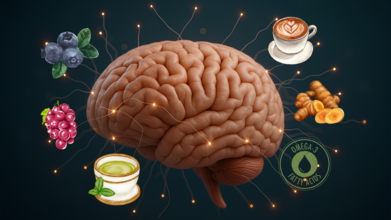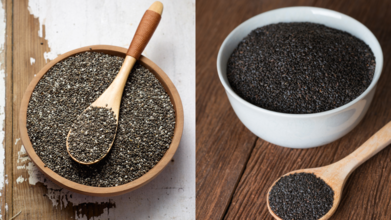- Health Conditions A-Z
- Health & Wellness
- Nutrition
- Fitness
- Health News
- Ayurveda
- Videos
- Medicine A-Z
- Parenting
- Web Stories
Think You Cannot Grow Brain Cells In Adulthood? These 7 Foods Say Otherwise, According to a Harvard Doctor

For years, we were told that growing new brain cells in adulthood was impossible. Once the brain matured, that was it. No going back, and that you will only slowly lose memory. But science has proven otherwise. Research shows that we can actually and do grow new brain cells even into old age. But do you know what really stimulates brain cell growth? The protein is called BDNF or brain-derived neurotrophic factors. And according to Dr. Terry Shintani, a Harvard-trained physician and nutritionist, this magical protein helps existing brain cells survive and encourages the growth of new ones.
Dr. Shintani lists the top seven foods that could boost brain cell growth and keep memory sharp, meaning these foods can increase BDNF levels naturally.
1. Blueberries
Blueberries are not for the cheesecakes alone. These tiny but mighty fruits are packed with anthocyanins, powerful antioxidants that cross the blood-brain barrier to increase BDNF. Regular munching could mean better memory and slower cognitive ageing.
2. Red Grapes
Unlike the green ones, these red, round grapes have seeds. Known as red globes, the seeds in it should not be stopping you from liking this variety. Red grapes are loaded with resveratrol and help reduce brain inflammation, increase BDNF levels, and may even guard against Alzheimer’s. Snack on them fresh or frozen. And sorry, wine does not count.
3. Green Tea
A glass of green tea is not only for your aesthetic Instagram feed. Green tea contains EGCG (epigallocatechin gallate), a compound shown to promote the growth of brain cells and enhance connectivity. So sip your way to sharper focus and calm.
4. Coffee
Your obsession with a glass of morning latte or espresso should not go in vain. It is worth knowing that a morning cup of coffee brings more than a caffeine kick. It contains chlorogenic acid, which has neuroprotective effects and helps stimulate BDNF production. Just go easy on the sugar.
5. Turmeric
A favourite in every Indian kitchen, turmeric is actually a star! Curcumin, the performing compound in turmeric, has been shown to increase BDNF levels, reduce brain fog, and possibly improve mood. Pair it with black pepper for better absorption and results.
6. Omega-3 Fatty Acids
If you are a vegan, vegetarian or meat eater, omega-3 is for all. Found in chia seeds, flaxseeds, and fatty fish like salmon, omega-3s support the structure of brain cells and boost BDNF. They are basically brain fuel wrapped in delicious, oily goodness.
7. Dark Chocolate
Oh yes, apart from taking care of your heart, a good-quality dark chocolate (70 per cent cacao or more), rich in polyphenols and procyanidins, can protect brain cells and increases BDNF. Yes, chocolate can be medicinal if taken in moderation.
Why It All Matters
Most people do not realise their daily diet could be doing their brain a massive favour or serious damage. With the right foods, we are not just preserving brain function; we are actually stimulating new growth, even in older adults. This shift in thinking changes how we approach brain ageing. Memory loss does not have to be inevitable. Neurodegenerative diseases like Alzheimer’s may not be entirely preventable, but your odds look a lot better with BDNF-boosting foods in your corner.
Do not rely on just one or two of these brain boosters. The more variety you pack into your daily meals, the better the BDNF production and brain benefit. It is noteworthy that your brain is not stuck in the past, and neither should your diet be. If you thought your neurone count peaked in your twenties, it is time to rewire that idea.
Anti-Allergy Diets: Dietician Reveals How To Naturally Build Immunity Through Nutrition

Credits: Canva
Allergies are more common than ever with nearly 6% of adults and children in the US have some form of food allergy, and that number continues to rise. Whether it’s a peanut reaction, seasonal sneezing, or unexplained flare-ups after certain meals, allergies are increasingly linked to the immune system’s overreaction. And here’s where it gets interesting, your diet might be the missing link—not just in managing symptoms, but in preventing them in the first place.
The mainstream response to allergies often begins and ends with antihistamines but according to certified dietitian Lavleen Kaur, healing starts from within, “Allergies—whether triggered by food, weather changes, or environmental factors—are signs of an overactive immune system. True healing begins from within. Building natural immunity through nutrition is a long-term, sustainable approach that not only helps prevent allergic flare-ups but also strengthens overall health.”
Expert dietician reveals how your food and lifestyle choices can shape your immune response—and how a few shifts could help you reduce allergic reactivity naturally.
Immune System Starts in the Gut
Roughly 70% of your immune system lives in your gut. This isn’t just an interesting stat—it’s the reason nutrition plays such a central role in how your body handles allergens. A gut that’s inflamed, leaky, or dominated by bad bacteria is more likely to misfire, reacting to harmless proteins in food or the environment.
Kaur emphasizes the importance of nurturing this digestive-immune connection: “When the digestive system is strong, the immune system becomes less reactive. That’s why I often say, ‘Immunity begins at home’—not through expensive supplements, but through simple, consistent habits rooted in traditional wisdom.”
Start Your Day with Immunity-Boosting Rituals
Forget the hype around complicated health tonics. According to Kaur, the day should start with an old-school combination that’s surprisingly effective: one fig, two dates, and 3–4 black raisins, soaked overnight. “This combination is rich in iron, helps build stamina, and keeps oxygen flowing efficiently in the body,” she says.
Follow that up with probiotic-rich foods like curd, fermented kanji, or buttermilk. These naturally populate your gut with beneficial bacteria, improve digestion, and enhance immune balance.
Hydration is another non-negotiable. “Pale-yellow urine is a sign you’re well-hydrated,” says Kaur. She recommends rotating plain water with coconut water, herbal teas, and turmeric-ginger infusions—especially during allergy season, when respiratory health is easily compromised.
Eat with the Seasons, Not the Supermarket Shelf
There’s a reason your grandmother swore by seasonal eating. Fresh, in-season produce isn’t just better for the planet—it’s better for your immune system. Kaur urges people to “fill your plate with a rainbow of seasonal fruits and vegetables, especially those high in vitamin C like amla, guava, oranges, and bell peppers.”
Another group of nutrients to focus on? Quercetin and omega-3 fatty acids. Quercetin—a powerful antioxidant found in apples and onions—helps modulate the body’s histamine response, meaning fewer flare-ups. Omega-3s from flaxseeds, walnuts, and chia seeds work at the cellular level to reduce inflammation and balance immunity.
Gut Rituals that Support Allergy Relief
Beyond meals, Kaur recommends ancient digestive practices that keep the gut calm and efficient. After meals, chew a small amount of fennel seeds, cardamom, or clove with jaggery. This supports digestion and prevents the post-meal sluggishness that can signal immune stress.
At bedtime, her go-to ritual is a glass of warm turmeric milk. Turmeric is anti-inflammatory, and combining it with milk (or a plant-based alternative) enhances absorption. This simple step not only improves sleep but supports overnight cellular repair and immune regeneration.
Identify Your Real Triggers
What derails your immunity faster than pollen season? Ultra-processed foods. Refined sugar, deep-fried snacks, chemical additives, and preservative-laden packages are well-known immune suppressors. These foods also disrupt gut flora and increase inflammation, making your system more reactive.
Some people may benefit from limiting gluten or dairy, especially if allergies persist despite clean eating but Kaur cautions that elimination should always be done under guidance. “Removing a food group without support can lead to deficiencies. The goal is to reduce inflammation—not create new problems.”
Ancient Ayurvedic Ways To Relive Allergy
Modern medicine isn’t the only tool available for allergy relief. Kaur encourages integrating Ayurvedic practices like:
- Udvartan (herbal dry massage) for detoxifying the skin
- Nasya therapy (medicated nasal drops) for clearing the sinuses and balancing the mind
- Shirodhara (streaming warm oil over the forehead) to regulate nervous system sensitivity
These therapies support the body's natural detox processes and promote systemic balance—especially helpful for those with chronic skin, respiratory, or seasonal allergies.
If you’re looking for a magic pill or a shortcut, nutrition-led immunity might disappoint you. But if you’re after something sustainable, preventive, and empowering, this approach could change your life.
Building a stronger immune system isn’t about perfection. It’s about consistency. Kaur puts it simply: “When the body is nurtured consistently through nutrition and lifestyle, it becomes less reactive, more resilient, and deeply aligned with nature.”
In a world overflowing with medications, allergy shots, and crisis responses, the anti-allergy diet offers a grounded, proactive path—one meal, one habit, one day at a time.
Allergies don’t have to control your life. By rethinking your plate, daily rituals, and how you support your gut, you can create an environment where your immune system works with you—not against you. Nutrition won’t replace your EpiPen, but it might help you reach for it less often and that’s worth chewing on.
Lavleen Kaur is the Chief Dietitian & Founder, Santushti Holistic Healthcare & Diet Insight Nutrition Academy
Chia Seeds vs Sabja (Basil) Seeds: How They Differ in Health Benefits

Chia seeds and sabja seeds may look similar, but they offer very different health benefits. While both are packed with nutrients and easy to include in your daily diet, choosing the right one depends on your specific health needs, whether it is improving digestion, managing cholesterol, or boosting protein intake.
Here is a closer look at how they compare and what each seed can do for your body.
Chia Seeds
They are a powerhouse of Omega-3 fatty acids, which play a crucial role in reducing inflammation and protecting your heart. That means if your diet is looking a little too oily or your cholesterol numbers are not looking good, chia can be a new good thing for your heart.
Chia seeds are a complete protein; they contain all nine essential amino acids your body cannot make on its own. That is rare in the plant world. Compared to sabja (basil) seeds, chia packs in more protein per serving, making it an ideal option for vegetarians or anyone looking to level up their protein intake without touching a protein bar that tastes like cardboard.
Chia seeds are also a great source of micronutrients--magnesium, copper, selenium. These nutrients do not just sound healthy; they help with blood sugar regulation and energy production and may even support diabetes management.
Sabja (Basil) Seeds
Sabja seeds (also known as basil seeds) are cooling by nature; they are your go-to during the sweaty summer months or when your gut is acting up.
Feeling bloated, constipated, or trapped in a never-ending acidity cycle? Sabja has your back. It is rich in fibre, which helps keep your digestion smooth, your tummy calm, and your gut bacteria dancing.
But do not dismiss sabja as just another seed. It is loaded with flavonoids and polyphenols, two antioxidant groups that fight inflammation and protect your skin. So if you are breaking out more than usual, sabja could help you cool down from the inside out.
And yes, it is especially loved in Ayurvedic traditions for helping with acne, skin irritation, and generally bringing a calming effect to the body.
Chia vs Sabja
Here is a quick reality check: they are both great, but for different reasons.
Chia has omega-3 fatty acids.
Chia has complete protein.
Chia has micronutrients (magnesium, selenium, etc.).
Sabja offers digestive support (constipation, gas, acidity).
Sabja offers an antioxidant punch.
Sabja offers acne-fighting benefits.
How to Use Them
Chia: Add it to smoothies, puddings, or overnight oats. Soak them in water or almond milk for at least 30 minutes to avoid the dreaded chia belly.
Sabja: Best soaked in water for 10-15 minutes. Use in lemon water, faloodas, rose milk, or just sip throughout the day as a cooling tonic.
You do not have to pick sides. Some days you will need the heart-helping, protein-rich punch of chia; other days, your body will crave the calm, gut-soothing embrace of sabja. Balance is key. Let chia handle your protein goals and sabja soothe your stressed skin and stomach.
Celebrity Nutritionist Shares 2 Foods For Lunch That Help Avoid Afternoon Slump

If lunch leaves you ready to pass out face-first on your keyboard, you are not alone. That dreaded afternoon slump is as real as that 4 pm coffee craving. It hits hard, dragging you into a state of foggy fatigue, irritability, and desperate tea breaks. But according to celebrity nutritionist Rujuta Diwekar, there is a surprisingly simple way to dodge this daily crash, and it starts with your lunch plate.
Diwekar, who works with stars like Kareena Kapoor, Alia Bhatt, Varun Dhawan, Saif Ali Khan and Karisma Kapoor, recently shared on Instagram two old-school yet powerful food additions that could keep you alert, happy, and fully functional post-lunch.
Afternoon slump means sleepiness. It feels like if you do not have tea, coffee or a cigarette, you will go into a coma. Sounds relatable? Absolutely. Diwekar also says that many people become cranky or snappy after lunch, and it is no coincidence. In fact, she jokes that some office meetings are strictly scheduled before lunch because nobody wants to deal with a post-meal grump.
But if you want to avoid that post-lunch crash, Diwekar recommends making two key additions to your midday meal: ghee and chutney.
1. Why Ghee
Yes, that ghee. The very ingredient many of us banished from our diets in the name of weight loss. “A lot of people tell me they have been putting on weight over time, or they are dealing with issues like thyroid imbalance or pigmentation,” says Diwekar. “Some even struggle with stubborn constipation and spend more time in the bathroom than they would like to admit.”
However, she advises bringing ghee back. A teaspoon of ghee in your lunch can be a game-changer. It helps with:
- Absorbing fat-soluble vitamins like D and B12
- Balancing hormones and supporting thyroid health
- Improving gut function and digestion
- Nourishing the skin from within
- Boosting energy levels naturally
Ghee provides slow-release energy, meaning your body does not go into a crash-and-burn cycle post digestion. Instead, you feel energised, calm and less likely to reach for sugar, caffeine, or cigarettes.
2. Why Chutney
Not ketchup or mayo. She is talking about real chutney, the kind your mum or grandmother probably made from scratch. “The second thing that needs to be part of your lunch is any kind of chutney,” says Diwekar. “We make coconut chutney, curry leaves chutney, lentil chutney, flaxseed chutney. There are so many chutneys in our collective cuisine.”
And it is not just about taste. These spicy, tangy, herby blends are packed with micronutrients, fibre and digestive enzymes that aid in the smooth breakdown of your food. They help prevent bloating, keep your gut flora happy and add a fresh zing to your plate.
Here are some great options:
- Coconut chutney: cooling, rich in good fats
- Curry leaf chutney: great for iron and hair health
- Flaxseed chutney: high in omega-3 and fibre
- Lentil chutney: protein-packed and grounding
Diwekar's core message is clear: health does not have to mean salads and smoothies. There are solutions sitting right in our kitchens. Instead of obsessing over complicated meal plans or imported ‘superfoods’, just eat in tune with traditional wisdom. The combination of ghee and chutney is centuries old, and it still works. A drizzle of ghee and a dollop of chutney might be all it takes to keep you breezing through your afternoon without the slump.
© 2024 Bennett, Coleman & Company Limited

